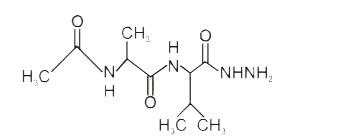Total number of peptide bond possible by mixing of valine and proline is
To determine the total number of peptide bonds possible by mixing valine and proline, we can follow these steps:
Step 1: Understand the Concept of Peptide Bonds
A peptide bond is formed between the carboxyl group of one amino acid and the amino group of another. This process involves the release of a water molecule (condensation reaction).
Step 2: Identify the Amino Acids
In this case, we are given two amino acids: valine (Val) and proline (Pro).
Step 3: Determine the Number of Amino Acids
We have a total of 2 amino acids (valine and proline).
Step 4: Use the Formula for Peptide Bonds
The formula to calculate the number of peptide bonds formed when mixing N amino acids is:
Number of peptide bonds=N−1
where N is the number of amino acids.
Step 5: Calculate the Number of Peptide Bonds
Substituting the value of N:
N=2
Number of peptide bonds=2−1=1
Conclusion
Thus, the total number of peptide bonds possible by mixing valine and proline is 1.
---
A peptide bond is formed between the carboxyl group of one amino acid and the amino group of another. This process involves the release of a water molecule (condensation reaction).
In this case, we are given two amino acids: valine (Val) and proline (Pro).
We have a total of 2 amino acids (valine and proline).
The formula to calculate the number of peptide bonds formed when mixing N amino acids is:
Number of peptide bonds=N−1
where N is the number of amino acids.
Substituting the value of N:
N=2
Number of peptide bonds=2−1=1
Thus, the total number of peptide bonds possible by mixing valine and proline is 1.
Topper's Solved these Questions
Similar Questions
Knowledge Check
The number of peptide bonds in the compound.
 A1B2C3D4
A1B2C3D4The number of peptide bonds in the compound
 is A1B2C3D4
is A1B2C3D4The total number of silicates possible are.
A2B10C5D6

